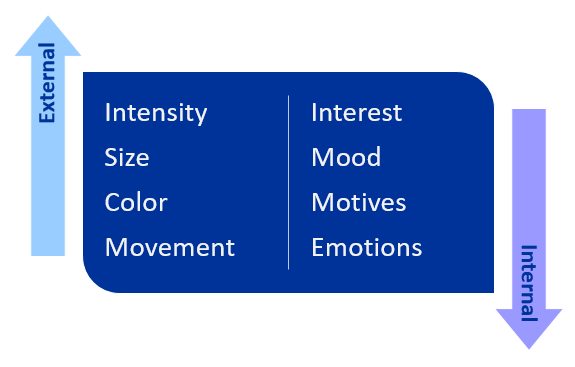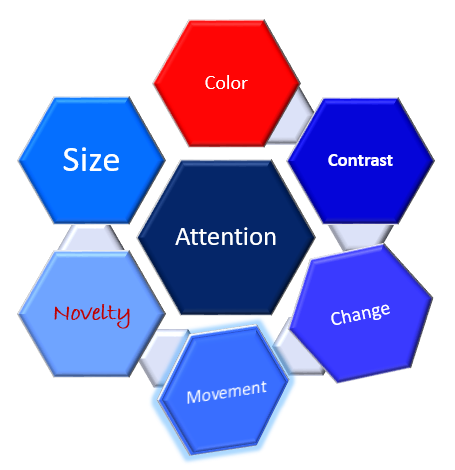Factors Affecting Attention
What is attention?
Attention is the cognitive process of focusing on stimuli in the environment that is relevant while tuning out other stimuli that is not. Several factors can affect or attract a person’s attention including loud sounds, bright lights, interest, and emotions.
Determinants of Attention
The factors affecting attention can be broken into two general categories:.
- External factors – comes through the senses
- Internal factors – already exists in the mind
There is a difference between selecting information which comes in through the senses (external) and information that is already existing in the mind (internal).
- External factors refers to the selection of sensory information that come from surroundings and make concentration on relevant stimuli easier or more difficult.
- Internal factors refers to the selection of internally generated information, such as mindset, memory, emotional state, or motives.
Factors Affecting Attention: External and Internal
External Factors
External factors are related to the characteristics of stimuli. There are external circumstances or stimuli that aid in attracting a person’s attention. These factors are generally those characteristics of outside situations or stimuli which helps capture attention.
Intensity
The more intense a stimulus is the more likely it will get someone’s attention. In other words, a person’s attention becomes easily directed towards a loud sound, a bright light or a strong smell. For example, a high wattage bulb will be noticed quicker than low wattage one, a bright vibrant color will be noticed faster than a faint color, or a loud sound quicker than a normal sound.
Size
Along with intensity is size. The bigger a stimulus is the more attention it captures. A large object will catch a person’s eye more readily than a small one. For example, a truck passing by will draw more attention than a bike passing by.
Change and Variety
Change and variety get attention more easily than uniformity and similarity. A change in the environment draws a person’s attention quickly. For example, people do not notice the humming of air conditioner until it stops. A radio can be playing songs and people not really notice, but if it stops playing due to power failure, it draws people’s attention.
Contrast
Stimuli contrasted against another draws more focus. Especially if there is significant contrast. An object that is strikingly different from its background draws more attention. For example, a red spot of sauce on a white shirt stands out more than a red spot on a red shirt. Also, people notice a word or a sentence in a paragraph if it is written in a different color or font more than other words or sentences in the same document.
Repetition of Stimulus
If stimulus is repeated several times, it is more likely to capture a person’s attention. A person may have missed it the first or second time, so the repetition increases the chances it gets the person attention. For example, when a teacher repeats the same key point, it is more likely to get the attention of the students.
Movement of the stimulus
A moving stimulus catches a person’s attention more easily than a stimulus that remains static. For example, a moving car draws more attention than a parked one, or flickering lights draws more attention than non-flickering lights.
Novelty
New or strange stimuli attract more attention than one that has been present. For example, a new object in a room typically gets more attention than one that has been there for some time.
Color
Colorful stimuli are more attention grabbing than black and white ones. Black and white objects do not stand out as much a colorful object. For example, more people would notice a colorful magazine cover than a black and white document.
Internal Factors
Internal factors refer to the thoughts and mental state of the perceiver. These factors predispose a person to respond to different objects or stimuli based on their personal desires, motives, interests and attitude.
Interest
Interest is one of the most important factors in attention. Simply put, people concentrate more on stimuli that interests them. For example, people watch a movie because they are interested in the characters or subject around which the movie revolves. People will go into a store because they are interested in the type of items being sold.
Desire and Motives
A person’s desire is a significant cause of paying attention to something. Desire motivates a person to seek out certain stimuli. If a person wants to see something or learn something, they will divert their attention towards it. For example, a person who wants to know how to play piano will seek out instructions or pay more attention to the piano teacher’s instructions.
Additionally, a person’s basic needs drive their attention in a significant way. Thirst, hunger, fear, safety and curiosity are a few of the primary factors that influence attention. For example, a hungry person is drawn to food or a thirsty person is more attracted to water than anything else.
Mindset
A person’s mindset or readiness to respond considerably determines his or her attention. A person’s readiness to reply to any stimulus makes that person more attentive. For example, if a person is busy, they may not answer a phone call, however, if they are eagerly awaiting a call, they will answer it immediately.
Additionally, if they need to pay attention, it will increase the likelihood of focusing on the specific stimuli. For example, if a person has a test, they will direct their focus towards it.
Moods and Attitudes
Typically, positive moods lead to better focus, while negative moods lead to poor concentration. Additionally, a person’s physical state can influence their mood. As a result, tiredness and discomfort might make focusing one’s attention more challenging. For example, people who are tired or angry have a harder time paying attention.
Emotions
Stimuli that provoke stronger emotions attract more attention. For example, a person who loves sports and is excited about a sporting event will concentrate on the activities of the game. On the other hand, emotions can have a negative effect. Another example is if a person is anxious due to fear, they may not listen or understand what is going on around them or what others are telling them.


